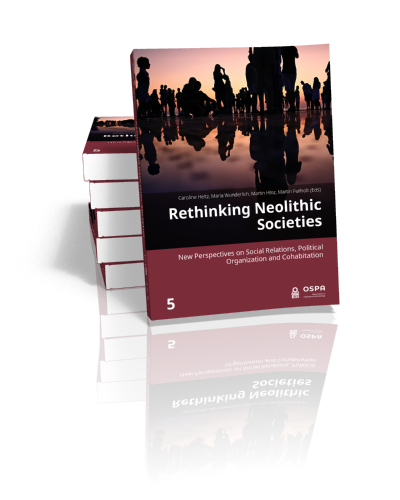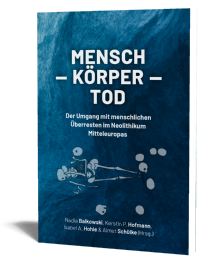Rethinking Neolithic Societies
New Perspectives on Social Relations, Political Organization and Cohabitation
Edited by Caroline Heitz, Maria Wunderlich, Martin Hinz, Martin Furholt | 2023

Rethinking Neolithic Societies
New Perspectives on Social Relations, Political Organization and Cohabitation
Edited by Caroline Heitz, Maria Wunderlich, Martin Hinz, Martin Furholt | 2023
Paperback ISBN: 9789464270662 | Hardback ISBN: 9789464270679 | Imprint: Sidestone Press Academics | Format: 210x280mm | 294 pp. | Open Series in Prehistoric Archaeology 5 | Series: OSPA: Open Series in Prehistoric Archaeology | Language: English | 14 illus. (bw) | 63 illus. (fc) | Keywords: archaeology; prehistory; neolithic; social organization; communities; societies; politics; identity; social theory; spatiality; temporality; materialism | download cover | DOI: 10.59641/ndr028gp | CC-license: CC BY-NC 4.0
Read online or downloaded 3347 times
-
Digital & Online access
This is a full Open Access publication, click below to buy in print, browse, or download for free.
-
Buy via Sidestone (EU & UK)
-
Buy via our Distributors (WORLD)
For non-EU or UK destinations you can buy our books via our international distributors. Although prices may vary this will ensure speedy delivery and reduction in shipping costs or import tax. But you can also order with us directly via the module above.
UK international distributor
USA international distributor
-
Bookinfo
Paperback ISBN: 9789464270662 | Hardback ISBN: 9789464270679 | Imprint: Sidestone Press Academics | Format: 210x280mm | 294 pp. | Open Series in Prehistoric Archaeology 5 | Series: OSPA: Open Series in Prehistoric Archaeology | Language: English | 14 illus. (bw) | 63 illus. (fc) | Keywords: archaeology; prehistory; neolithic; social organization; communities; societies; politics; identity; social theory; spatiality; temporality; materialism | download cover | DOI: 10.59641/ndr028gp | CC-license: CC BY-NC 4.0
Read online or downloaded 3347 times

We will plant a tree for each order containing a paperback or hardback book via OneTreePlanted.org.
Traditional archaeological ideas about Neolithic societies were shaped by questionable premises. The modern concept of social and cultural coherence of residence groups as well as the ethnic interpretation of ‘archaeological cultures’ fostered ideas of static and homogeneous social entities with fixed borders. Farming – as the core of the Neolithic way of life – was associated with sedentariness rather than with spatial mobility and cross-regional social networks. Furthermore, the widely used (neo-)evolutionist thinking universally assumed a growing social complexity and hierarchisation during prehistory. After all, such ‘top-down’–perspectives deprived individuals and groups of genuine agency and creativity while underestimating the relational dynamic between the social and material worlds. In recent years, a wide array of empirical results on social practices related to material culture and settlement dynamics, (inter-)regional entanglements and spatial mobility were published. For the latter the adoption of the relatively new scientific methods in archaeology like Stable Isotope Analysis as well as aDNA played a crucial role. Yet the question of possible inferences regarding spatial and temporal differences in forms of social organisation has not been addressed sufficiently.
The aim of this volume is therefore to rethink former top-down concepts of Neolithic societies by studying social practices and different forms of Neolithic social life by adopting bottom-up social archaeological perspectives. Furthermore, the validity and relevance of terms like ‘society’, ‘community’, ‘social group’ etc. will be discussed. The contributions reach from theoretical to empirical ones and thematize a variety of social theoretical approaches as well as methodological ways of combining different sorts of data. They show the potential of such bottom-up approaches to infer models of social practices and configurations which may live up to the potential social diversity and dynamism of Neolithic societies. The contribution shed light on spatial mobility, social complexity, the importance of (political) interests and factors of kinship etc. We hope that this volume, with its focus on the Neolithic of Europe, will contribute to the ongoing critical debates of theories and concepts as well as on our premises and perspectives on Neolithic societies in general – and the practices of social archaeology as such.
PART I: INTRODUCTION
Promoting bottom-up approaches to social archaeology
Maria Wunderlich, Caroline Heitz, Martin Hinz, Martin Furholt
PART II: CONCEPTUAL AND METHODOLIGICAL APPROACHES TO FORMS OF SOCIAL ORGANISATION
Anarchy: Anthropological reflections on an unruly concept
Till Förster
Negotiating power in Neolithic communities: The politics of cohabitation
Martin Furholt
From “communities of practice” to “translocal communities”: A practice-theoretical approach to mobility and the sociospatial configurations of Neolithic groups
Caroline Heitz
Ethnoarchaeology and agent-based simulation modelling as bottom-up approaches: Perspectives for archaeological research
Maria Wunderlich, Julian Laabs
PART III: MATERIAL DIMENSIONS OF SOCIAL ORGANISATION
The world in a village? Regional and supra-regional transmission of pottery-making practices in southwestern Germany in the early third millennium BC
Philipp Gleich
Tracing the evidence of Neolithic social groups’ mobility according to the ornamentation on ceramics from the Lysa Hora burial site
Marta Andriiovych
Lausanne-Vidy: From single to social?
Katharina V.M. Jungnickel
Perversion of the Pareto principle: Using a bottom-up approach to study burial practices in the Late Neolithic Carpathian Basin
Kata Szilágyi
PART IV: SCALES AND FORMS OF SOCIAL ORGANISATION
Setting the ground for a village: Communal organisation and space at the Early Neolithic site of Altscherbitz (Germany)
Isabel A. Hohle
Same but different: Cross-regional cultural entanglement during the first half of the third millennium BC – a view from Franconia
Thomas Link
How wide are social frames of cultural diversity and mutual cultural influences?
Aleksandr Diachenko, Iwona Sobkowiak-Tabaka
PART V: SYNTHESES: AFTERTHOUGHTS, REFLECTIONS AND OUTLOOK
Purging our approach to Neolithic societies: A critical review of the terms, analytical categories, and cultural concepts applied in research
Brigitte Röder
Abandoning Neolithic societies: A practice-based approach
Alexander Veling
Theory versus data: Dealing with the interpretive dilemma in the biomolecular era
Maxime N. Brami
Contact details of the authors

Dr. Caroline Heitz
Caroline Heitz is a Senior Researcher and SNSF-Ambizione Grantee at the Institute of Archaeological Sciences and the Oeschger Center for Climate Change Research at the University of Bern. In her award-winning doctoral thesis, she combined research on mobility, entanglement, appropriation, and transformation in relation to Neolithic pottery from the UNESCO-World Heritage wetland sites around the Alps. She was also awarded a Postdoc-Mobility Grant from the Swiss National Science Foundation and became a fellow at the Universities of Oxford and Kiel in 2021–2022. She is currently conducting research on social archaeology as well as climate change resilience and vulnerabilities of prehistoric waterfront communities.
Dr. Martin Hinz
Martin Hinz is a Lecturer and Research Fellow at the Institute of Archaeological Sciences and Research Associate of the Oeschger Center for Climate Change Research at the University of Bern. His current focus is the combination of scientific data, quantitative methods and archaeological knowledge, particularly in respect to the Neolithic and Bronze Age in Switzerland.

Prof. Dr. Martin Furholt
Martin Furholt is Professor of Social Archaeology at Kiel University. His main research interests are the political dimension of social organisation in the past, and prehistoric mobility during the Neolithic and Bronze Age periods in Europe. He is currently conducting fieldwork on 6th and 5th millennium BCE Neolithic settlement in Slovakia and Serbia, and publishes papers related to the ongoing 3rd millennium migration debate in Europe.
Dr. Maria Wunderlich
Maria Wunderlich is currently a Lecturer and Research Fellow at the Institute of Pre-and Protohistoric Archaeology, Kiel University. For her PhD-studies between 2014 and 2018 she was involved in the DFG-project “Equality and Inequality: Social Differentiation in Northern Central Europe 4300-2400 BC” as a research assistant. For her comparative thesis on “Megalithic monuments and social structures” she conducted ethnoarchaeological field work in Sumba, Indonesia, and Nagaland, North-East India. Being interested in social archaeology and comparative analyses, she combines different theoretical approaches with material data derived both in recent and archaeological contexts.
Abstract:
Traditional archaeological ideas about Neolithic societies were shaped by questionable premises. The modern concept of social and cultural coherence of residence groups as well as the ethnic interpretation of ‘archaeological cultures’ fostered ideas of static and homogeneous social entities with fixed borders. Farming – as the core of the Neolithic way of life – was associated with sedentariness rather than with spatial mobility and cross-regional social networks. Furthermore, the widely used (neo-)evolutionist thinking universally assumed a growing social complexity and hierarchisation during prehistory. After all, such ‘top-down’–perspectives deprived individuals and groups of genuine agency and creativity while underestimating the relational dynamic between the social and material worlds. In recent years, a wide array of empirical results on social practices related to material culture and settlement dynamics, (inter-)regional entanglements and spatial mobility were published. For the latter the adoption of the relatively new scientific methods in archaeology like Stable Isotope Analysis as well as aDNA played a crucial role. Yet the question of possible inferences regarding spatial and temporal differences in forms of social organisation has not been addressed sufficiently.
The aim of this volume is therefore to rethink former top-down concepts of Neolithic societies by studying social practices and different forms of Neolithic social life by adopting bottom-up social archaeological perspectives. Furthermore, the validity and relevance of terms like ‘society’, ‘community’, ‘social group’ etc. will be discussed. The contributions reach from theoretical to empirical ones and thematize a variety of social theoretical approaches as well as methodological ways of combining different sorts of data. They show the potential of such bottom-up approaches to infer models of social practices and configurations which may live up to the potential social diversity and dynamism of Neolithic societies. The contribution shed light on spatial mobility, social complexity, the importance of (political) interests and factors of kinship etc. We hope that this volume, with its focus on the Neolithic of Europe, will contribute to the ongoing critical debates of theories and concepts as well as on our premises and perspectives on Neolithic societies in general – and the practices of social archaeology as such.
Contents
PART I: INTRODUCTION
Promoting bottom-up approaches to social archaeology
Maria Wunderlich, Caroline Heitz, Martin Hinz, Martin Furholt
PART II: CONCEPTUAL AND METHODOLIGICAL APPROACHES TO FORMS OF SOCIAL ORGANISATION
Anarchy: Anthropological reflections on an unruly concept
Till Förster
Negotiating power in Neolithic communities: The politics of cohabitation
Martin Furholt
From “communities of practice” to “translocal communities”: A practice-theoretical approach to mobility and the sociospatial configurations of Neolithic groups
Caroline Heitz
Ethnoarchaeology and agent-based simulation modelling as bottom-up approaches: Perspectives for archaeological research
Maria Wunderlich, Julian Laabs
PART III: MATERIAL DIMENSIONS OF SOCIAL ORGANISATION
The world in a village? Regional and supra-regional transmission of pottery-making practices in southwestern Germany in the early third millennium BC
Philipp Gleich
Tracing the evidence of Neolithic social groups’ mobility according to the ornamentation on ceramics from the Lysa Hora burial site
Marta Andriiovych
Lausanne-Vidy: From single to social?
Katharina V.M. Jungnickel
Perversion of the Pareto principle: Using a bottom-up approach to study burial practices in the Late Neolithic Carpathian Basin
Kata Szilágyi
PART IV: SCALES AND FORMS OF SOCIAL ORGANISATION
Setting the ground for a village: Communal organisation and space at the Early Neolithic site of Altscherbitz (Germany)
Isabel A. Hohle
Same but different: Cross-regional cultural entanglement during the first half of the third millennium BC – a view from Franconia
Thomas Link
How wide are social frames of cultural diversity and mutual cultural influences?
Aleksandr Diachenko, Iwona Sobkowiak-Tabaka
PART V: SYNTHESES: AFTERTHOUGHTS, REFLECTIONS AND OUTLOOK
Purging our approach to Neolithic societies: A critical review of the terms, analytical categories, and cultural concepts applied in research
Brigitte Röder
Abandoning Neolithic societies: A practice-based approach
Alexander Veling
Theory versus data: Dealing with the interpretive dilemma in the biomolecular era
Maxime N. Brami
Contact details of the authors

Dr. Caroline Heitz
Caroline Heitz is a Senior Researcher and SNSF-Ambizione Grantee at the Institute of Archaeological Sciences and the Oeschger Center for Climate Change Research at the University of Bern. In her award-winning doctoral thesis, she combined research on mobility, entanglement, appropriation, and transformation in relation to Neolithic pottery from the UNESCO-World Heritage wetland sites around the Alps. She was also awarded a Postdoc-Mobility Grant from the Swiss National Science Foundation and became a fellow at the Universities of Oxford and Kiel in 2021–2022. She is currently conducting research on social archaeology as well as climate change resilience and vulnerabilities of prehistoric waterfront communities.
Dr. Martin Hinz
Martin Hinz is a Lecturer and Research Fellow at the Institute of Archaeological Sciences and Research Associate of the Oeschger Center for Climate Change Research at the University of Bern. His current focus is the combination of scientific data, quantitative methods and archaeological knowledge, particularly in respect to the Neolithic and Bronze Age in Switzerland.

Prof. Dr. Martin Furholt
Martin Furholt is Professor of Social Archaeology at Kiel University. His main research interests are the political dimension of social organisation in the past, and prehistoric mobility during the Neolithic and Bronze Age periods in Europe. He is currently conducting fieldwork on 6th and 5th millennium BCE Neolithic settlement in Slovakia and Serbia, and publishes papers related to the ongoing 3rd millennium migration debate in Europe.
Dr. Maria Wunderlich
Maria Wunderlich is currently a Lecturer and Research Fellow at the Institute of Pre-and Protohistoric Archaeology, Kiel University. For her PhD-studies between 2014 and 2018 she was involved in the DFG-project “Equality and Inequality: Social Differentiation in Northern Central Europe 4300-2400 BC” as a research assistant. For her comparative thesis on “Megalithic monuments and social structures” she conducted ethnoarchaeological field work in Sumba, Indonesia, and Nagaland, North-East India. Being interested in social archaeology and comparative analyses, she combines different theoretical approaches with material data derived both in recent and archaeological contexts.
-
Digital & Online access
This is a full Open Access publication, click below to buy in print, browse, or download for free.
-
Buy via Sidestone (EU & UK)
-
Buy via our Distributors (WORLD)
For non-EU or UK destinations you can buy our books via our international distributors. Although prices may vary this will ensure speedy delivery and reduction in shipping costs or import tax. But you can also order with us directly via the module above.
UK international distributor
USA international distributor
- Browse all books by subject
-
Search all books

We will plant a tree for each order containing a paperback or hardback book via OneTreePlanted.org.
You might also like:
© 2026 Sidestone Press KvK nr. 28114891 Privacy policy Sidestone Newsletter Terms and Conditions (Dutch)








